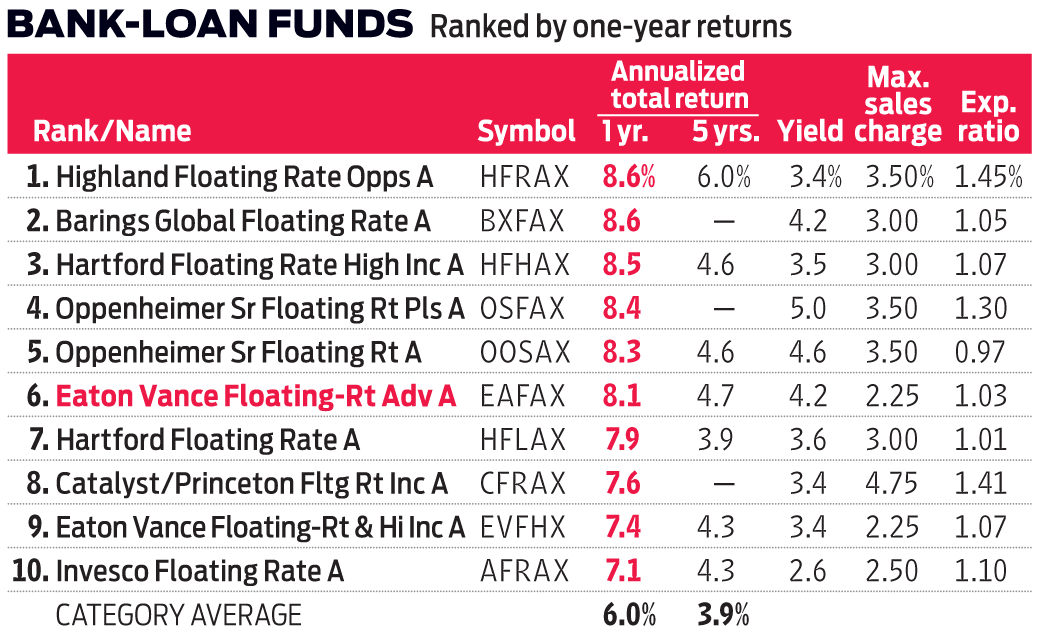This Fund Banks on Bank Loans
Eaton Vance Floating-Rate Advantage should thrive as interest rates rise.


For income seekers, rising interest rates often mean trouble. That’s because prices of bonds usually fall when rates climb. One way to defend against rising rates is to invest in floating-rate loans. Rates on these loans, which banks make to businesses, are pegged to short-term benchmarks and typically reset every 30 to 90 days. That means that when rates rise, the interest you receive on these IOUs, also called “leveraged loans,” goes up as well.
Because many investors expect rates to rise, they have been pouring money into bank loans. But these investments come with another kind of risk. Firms that take out floating-rate loans typically carry sub-investment-grade credit ratings and are more likely to default than less-indebted, higher-quality firms.
For most people, the best way to invest in bank loans is through a mutual fund, such as Eaton Vance Floating-Rate Advantage (symbol EAFAX), that avoids loans to high-risk borrowers. Managers Scott Page and Craig Russ, along with a team of 29 researchers, start by weeding out the smallest borrowers as well as companies that have too much debt. The team favors loans issued to established companies with ample earnings and assets to cover their debts. To be considered for inclusion in the portfolio, a loan must be “senior secured,” meaning that in the case of a default, holders of the loan have first dibs on the company’s assets—even before bondholders.
From just $107.88 $24.99 for Kiplinger Personal Finance
Become a smarter, better informed investor. Subscribe from just $107.88 $24.99, plus get up to 4 Special Issues

Sign up for Kiplinger’s Free Newsletters
Profit and prosper with the best of expert advice on investing, taxes, retirement, personal finance and more - straight to your e-mail.
Profit and prosper with the best of expert advice - straight to your e-mail.
Nearly all of the fund’s holdings carry below-investment-grade ratings, but the managers skew toward better-quality junk. At last report, the fund had 86% of its assets in double-B and single-B-rated loans (the highest junk ratings), compared with 69% for the average bank-loan mutual fund. Those loans the managers deem the least risky occupy the largest positions in the portfolio, but no loan commands more than 1% of assets. The strategy, the managers say, is to win more by losing less.
Of course, they are still trying to win. To juice up the fund’s yield, the managers borrow the equivalent of 20% to 30% of its assets and use the proceeds to invest in additional bank loans. The fund’s Class A shares currently yield an above-average 4.2%. They come with a 2.25% sales charge, but are available without a load or transaction fee at several online brokers.

Profit and prosper with the best of Kiplinger's advice on investing, taxes, retirement, personal finance and much more. Delivered daily. Enter your email in the box and click Sign Me Up.

Ryan joined Kiplinger in the fall of 2013. He wrote and fact-checked stories that appeared in Kiplinger's Personal Finance magazine and on Kiplinger.com. He previously interned for the CBS Evening News investigative team and worked as a copy editor and features columnist at the GW Hatchet. He holds a BA in English and creative writing from George Washington University.
-
 5 Investment Opportunities in 2026
5 Investment Opportunities in 2026As investors game-plan for the year ahead, these five areas of the equity markets deserve their attention.
-
 How Verizon’s Free Phone Deals Work
How Verizon’s Free Phone Deals WorkWhat shoppers need to know about eligibility, bill credits and plan costs.
-
 Does Your Car Insurer Need to Know All Your Kids? Michigan Cases Raise Question
Does Your Car Insurer Need to Know All Your Kids? Michigan Cases Raise QuestionWho you list on your policy matters more than most drivers realize, especially when it comes to who lives in your home.
-
 What Fed Rate Cuts Mean For Fixed-Income Investors
What Fed Rate Cuts Mean For Fixed-Income InvestorsThe Fed's rate-cutting campaign has the fixed-income market set for an encore of Q4 2024.
-
 The Most Tax-Friendly States for Investing in 2025 (Hint: There Are Two)
The Most Tax-Friendly States for Investing in 2025 (Hint: There Are Two)State Taxes Living in one of these places could lower your 2025 investment taxes — especially if you invest in real estate.
-
 The Final Countdown for Retirees with Investment Income
The Final Countdown for Retirees with Investment IncomeRetirement Tax Don’t assume Social Security withholding is enough. Some retirement income may require a quarterly estimated tax payment by the September 15 deadline.
-
 Dividends Are in a Rut
Dividends Are in a RutDividends may be going through a rough patch, but income investors should exercise patience.
-
 Municipal Bonds Stand Firm
Municipal Bonds Stand FirmIf you have the cash to invest, municipal bonds are a worthy alternative to CDs or Treasuries – even as they stare down credit-market Armageddon.
-
 High Yields From High-Rate Lenders
High Yields From High-Rate LendersInvestors seeking out high yields can find them in high-rate lenders, non-bank lenders and a few financial REITs.
-
 Time to Consider Foreign Bonds
Time to Consider Foreign BondsIn 2023, foreign bonds deserve a place on the fringes of a total-return-oriented fixed-income portfolio.
-
 The 5 Best Actively Managed Fidelity Funds to Buy and Hold
The 5 Best Actively Managed Fidelity Funds to Buy and Holdmutual funds Sometimes it's best to leave the driving to the pros – and these actively managed Fidelity funds do just that, at low costs to boot.